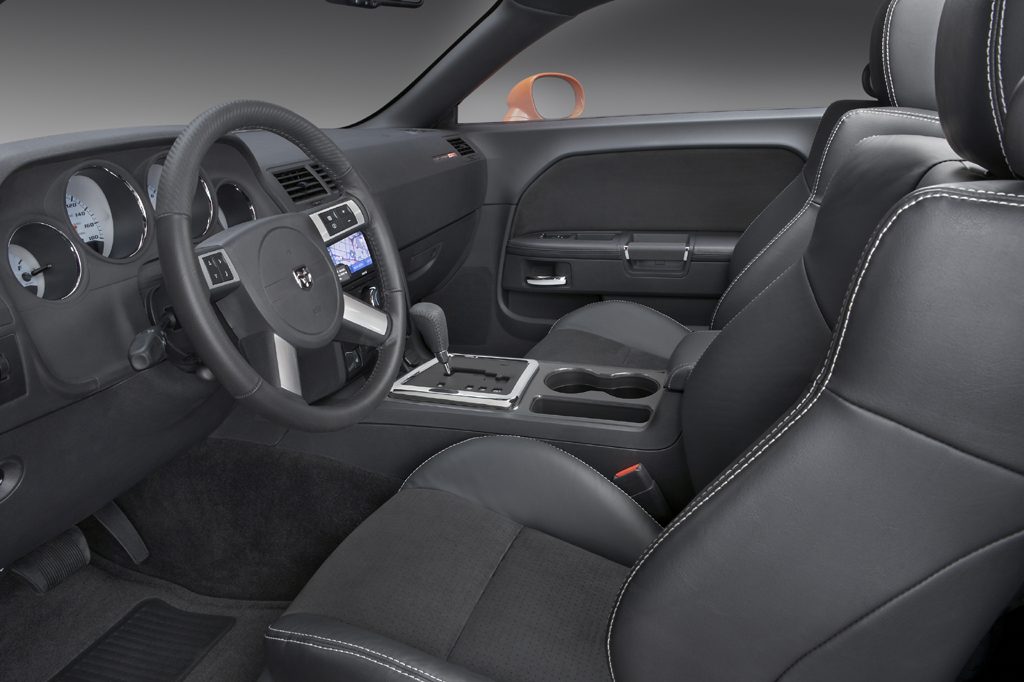| Sporty/performance car; Built in Canada |
|
|
| Good condition price range: $12,100 – $39,700* |

2009 Dodge Challenger Front

2008 Dodge Challenger Rear

2008 Dodge Challenger Interior

2008 Dodge Challenger Exterior
| Pros: |
|
| Cons: |
|
Challenger may not be an ideal choice for those looking to save on gas, at least in V8 form. That said, Dodge’s fun-to-drive, retro-themed muscle machine comes off as more practical and markedly less expensive than Chevrolet’s Corvette.
Overview
Dodge launched the 2008 Challenger as a revival of a classic Chrysler Corporation name. Retro-styled to mimic the original model, which was marketed in 1970-74, the Challenger aimed to compete with Ford’s Mustang and the soon-to-be-reborn Chevrolet Camaro. Fans of the Chevrolet Corvette and Nissan 370Z also might take an interest, but Mustang and Camaro were the prime targets for Dodge.
Initially, this rear-wheel-drive sporty/performance midsize coupe was available only in SRT8 trim, which featured a 425-horsepower 6.1-liter Hemi V8 mated to a five-speed automatic transmission with a manual shift gate. Seating five, the midsize coupe had safety features that included antilock braking, traction control, an antiskid system, curtain side airbags, and front side airbags.
Each 2008 Challenger contained a limited-edition, numbered dashboard plaque, as well as faux carbon-fiber hood stripes. Only three body colors were offered, including Hemi Orange. Available features included a navigation system, “Keyless Go” entry, “MyGig” infotainment, and uconnect hands-free communication. It was announced that additional models and powertrains were planned for the 2009 model year.
Yearly Updates
| 2009 Challenger New Challenger models joined the original SRT8. The new entry-level SE coupe held a 250-horsepower 3.5-liter V6 engine, mated to a four-speed automatic transmission. A 372-horsepower 5.7-liter Hemi V8, working with a five-speed automatic, went into the new mid-level R/T model. A six-speed manual gearbox was available with the 5.7 V8, in which case the engine produced 376 horsepower. In automatic-transmission R/Ts, the engine featured Chrysler’s Multi-Displacement System, which deactivated cylinders under light-load conditions. Antilock braking, traction control, and an antiskid system were standard on the R/T and SRT8 models. A new six-speed manual gearbox became available for the super-performance SRT8 coupe, which retained the 425-horsepower 6.1-liter Hemi V8. Offered as an extra-cost option, the manual gearbox included a hill-holder clutch that held the brake for three seconds, to assist the driver when starting off on an incline. Keyless engine start was available. So was Chrysler’s uconnect multimedia suite, which could include a wireless cell-phone link, 30-gigabyte hard drive for storing digital music and picture files, and a navigation system. |
| 2010 Challenger The 2010 Dodge Challenger was available as a new, limited edition “Plum Crazy” model. The rest of this retro-styled sporty-car lineup saw no major changes otherwise. |
| 2011 Challenger The 2011 Dodge Challenger received a pair of new engines. SE models got a new 305-horsepower 3.6-liter V6, which replaced a 250-horsepower 3.5-liter V6. This engine can run on gasoline or E85 ethanol-blended fuel. SRT8 392 versions got a new 470-horsepower 6.4-liter V8, which replaced a 425-horsepower 6.1-liter V8. |
| 2012 Challenger The only change of note to the 2012 Dodge Challenger was that steering-wheel paddle shifters were now available. |
| 2013 Challenger For 2013, Challenger carried on with a few minor changes. Top-line versions got a launch-control system, which was designed to provide faster times when doing performance runs from a dead stop. |
| 2014 Challenger For 2014, Challenger offered some new option packages, but was otherwise unchanged. |
